-
TWO OF US / DEUX (Filippo Meneghetti, 2019)
FILIPPO MENEGHETTI: TWO OF US/DEUX (2019)
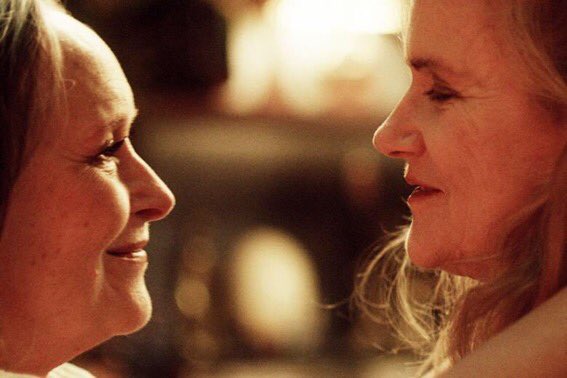
MARTINE CHEVALLIER, BARBARA SUKOWA IN TWO OF US/DEUS
Secret lesbian romance leads to complications in Italian Filippo Meneghetti's directorial debut, in French and set somewhere in the south of France and shot near Montpellier.
Former tour guide Nina Dorn (the handsome Barbara Sukowa, a protegee of Fassbinder), who lives in a facing apartment on the top floor of the building, has long been the lover of Madeleine (Martine Chevallier of the Comédie-Francaise), but secretly; no one, even Maddie's adult divorced daughter Anne (Léa Drucker), knows about this relationship, though how very loving and happy it is we are shown very clearly in scenes of sweetness and smiles. The couple is well into retirement age, but only now they are planning to sell Madeleine's very nice apartment and go to live together at last, in Rome where they met so many years ago. An Italian version of a corny but romantic pop song is their reminder of that moment; they dance to it still.
The plan is for Maddie to tell Anne about the relationship and the plan. Not surprisingly, after all these years of secrecy, in the event, at the end of a birthday dinner for her, she chokes. She just doesn't seem to be ready to do it. When Nina finds out this change of heart from the real estate agent, it's beyond disappointing and into infuriating. Nina speaks harshly with the more conventional Maddie in the street in front of the estate agent.
The result of this spat is dramatic indeed. Shortly thereafter, Maddie has a stroke. The bulk of the movie is what happens after that.
The film has had a good reception in France. It is slated for US release by Magnolia in Feb. 2021. It's in a good position, but its status as a bold work by a new director fits it, marginally, for the New Directors series, though it seems like firm arthouse material. I sympathize with the writer for the French publication Les Inrockuptibles who said it took two great actresses to crack the code of the sometimes clumsy and maladroit direction. There are many early hints, for instance, of a distance between the two women that are not appropriate; the camera is often either too close or too far away. Expressionism wasn't needed!
Meneghetti stirs up a good deal of melodrama, where it might do better to have drawn up a screenplay that showed how such very human problems might be safely resolved. After a while, we're just in a movie. The action seems to me rather implausible, and at once too eventful and too slow. But the look of the film is handsome, and the ladies are, needless to say, magnificent. Numerous viewers (Letterboxd, for instance) have expressed gratitude for a movie about older lesbians, and asked for more. In that this is welcome. Women who identify with Maddie and Nina will appreciate this film, even though its story details may not have that much to do with them.
Two of Us/Deux, 95 mins., debuted at Toronto and showed in at least 15 other international festivals, including ND/NF, as part of the virtual form of which it was reviewed for this film. AlloCiné press rating 3/6/5.
Last edited by Chris Knipp; 05-10-2021 at 09:32 AM.
-
RED MOON TIDE/LÚA VERMELHA (Lois Patiño 2020)
LOIS PATIÑO: RED MOON TIDE/LÚA VERMELhA (2020)
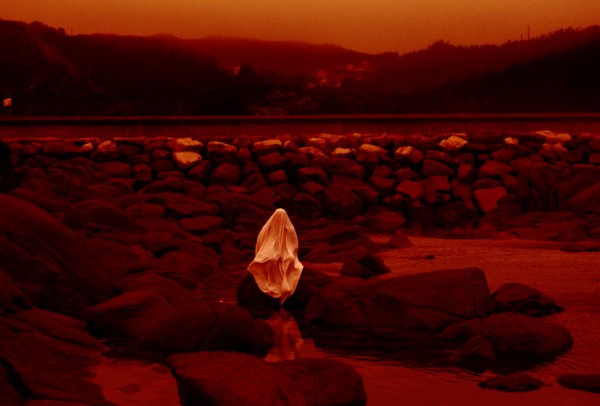
STILL FROM LUA VERMELA
Gorgeous images of a haunted world staged along the Galician coast of Spain
The young Spanish filmmaker Lois Patiño has a penchant for haunted, beautiful landscapes and for the human history embedded in his own native landscape. In this film the focus is on a fishing village along the Galician coast, rock tides, and death in the water. Village people, engaged for the film enterprise, lend their stubby bodies and stolid gazes to Patiño, who uses them arrestingly as statues or mannequins posed near the water, in a small grove, in an awesome, empty building, or in a quiet, old fashioned family house interior.
A simple narrative theme runs through the images. Rubio (Rubio de Camelle) is a fisherman who is also diver who has specialized for years in retrieving drowned bodies from shipwrecks, who himself has disappeared, and villagers speculate about whether he will reappear. He believed a monster is hunting the shores of his coastal town as he discovered corpses around as he takes his boat out in the morning. Now his boat has run aground, without Rubio. Gradually statue-like figures appear around in landscapes and architectural interiors, tall, thin, immobile, draped in shimmering white. There is talk of phantoms and ghosts and demons and three witches coming for people. Themes of death and the water come and go.
It's impossible to exaggerate how subtle and beautiful these images are, the soft yellow-filtered tints, the reds, the textures of cloth: everything is like a sculpture or something made out of sewn cloth. And the colors, toward the end, when red begins to prevail, you can lose yourself in them. It is indeed a gorgeous picture of a phantom world, dreamland, nightmare, or perverse paradise? The scenes unfold, one after another exquisitely composed tableaux that transform what might in some cases be only ordinary images of everyday Spanish village life into mythical wonders. And the moons! The 37-year-old Patiño has mastered the art of turning images of everyday lives into the mythical.
This is filmmaking that is largely a celebration of the visual. The dreams or nightmares of a lost fisherman and a world of lost souls, a project long in gestation are nonetheless somewhat underdeveloped as narrative. But if you're willing to sit back and enjoy the eye candy, there's something rather unique here. The transition from his short films to this feature length has been a little uneven. This may be a pretty long slog for some people.
In an interview with Film Comment, the filmmaker has said that this long-gestating film was at first meant to be more of a documentary. But, I'd say, he is just too much of an artist and a dreamer to be contented with the real. Toward the end of the process of making Red Moon Tide, he says he "got very deep into H.P. Lovecraft," so he "eventually tried" to "bring the story a little towards the terror genre." Everything he loves and knows, he put into it. It's thus a film to study more than simply go and watch.
Red Moon Tied/Lua vermelha, 84 mins., debuted at the Berlinale Feb. 2020, also showing at Malaga, IndieLIsboa and Toulouse. Screened for this review as part of the delayed FLC New Directors/New Films 2020, online Dec. 2020.
Last edited by Chris Knipp; 12-19-2020 at 01:49 AM.
-
ATLANTIS ( Valentyn Vasyanovych 2019)
VALENTYN VASYANOVYCH: ATLANTIS (2019)
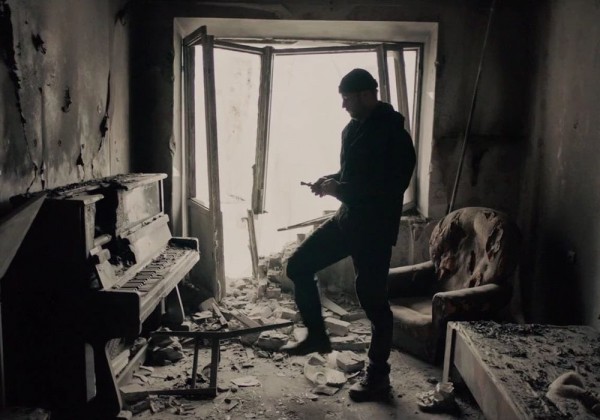
ANDRIY RYMARUK IN ATLANTIS
Ravaged young war veteran winds up helping people bury their dead: a formal survey of the physical and human toll of post-war Ukraine
Dennis Harvey's Variety review says simply, "Its cryptic, rigorously minimalist progress will test the patience of many viewers and present a challenge for commercial placements." So that is Atlantis in a nutshell. It may seem more like serving a stint in the military than watching a movie. You do get more of a look than you've ever had before of forensic examinations of long-dead corpses. But that is repeated more often than necessary, unless you are going to work for a coroner. Nonetheless Atlantis, set in Eastern Ukraine in 2025, is the tale of a young man who has been a solider in the war with Russia and slowly works his way back to something more like human life, and seems to succeed. The first time director who won first prize in the Horizons section at Venice this year with the film also succeeds in delivering a valid picture of the punishing series of steps that might be necessary for such a process as this. The punishment, for us, is mitigated after a while at least by appreciation of the formal elegance and control of the consistent sequence of horizontal compositions, with fixed camera positions.
When we meet Sergiy (Andriy Rymaruk) he's living in an isolated location with a war comrade and all they do in their spare time is target practice using big metal human targets. Their attempt at civilian life is very partial, consisting only of work at a steel mill about to be closed down. Such a clangorous environment isn't good for people with PTSD, and it takes a severe toll on Sergei's roommate.
Sergiy makes his way by accident to the forensic archaeology, as it might be called; a woman he works with turns out to have been an archaeology student, in fact. She considers this a logical continuation, archeology on ourselves. He has met her and gotten into this because he rescued her and her partner when their truck was stuck along the road as he was going on a long trek in a bigger truck.
In some of these scenes I felt I was in a Soviet social realist painting. The sense of focus on the function, not the individual, is intense.
One of the most memorable and unusual moments is the scene where Sergiy explores a cavernous building that leads to a room with a small piano. One assumes it may be where he used to live. It's all a wreck now, and yet, you wonder why he doesn't try to play the piano, which is more or less intact. Instead he quietly sets a Christ Crucified figure up on the piano top. While so many of the sequences seem more like demonstrations of equipment than experiences, this has the haunting quality of a ceremony and a dream.
As the Variety review says, most of this film is made up of "prolonged, stationary, symmetrically formal widescreen compositions of activity within various harsh vistas and decrepit interiors." This one departs from that. But toward the end, a relationship develops that shows Sergiy hasn't lost all ability to function as a human being. There's hope, for him. For the Ukraine territory where the fighting was, an expert assesses that it's uninhabitable - for decades, maybe hundreds of years. They won the war and destroyed the country. Win a few, lose a few. This film has not only a very distinctive vision and a unique experiential intensity but a compelling authenticity about it: the performers reportedly are all themselves Ukrainian war veterans.
Atlantis/Атлантида, 107 mins., debuted at Venice, winning best film in the Orizzonti section; numerous other nominatinons and awards; it has also shown in over two dozen other festivals including Toronto, Warsaw Hamburg, Tokyo, Vienna, Taipei, and in New Directors/New Films. As part of ND/NF in its delayed pandemic virtual form, Dec. 2021, it was viewed for this review. It is the 2021 Ukrainian entry in the Best International Feature Oscar competition.
Last edited by Chris Knipp; 07-08-2022 at 01:38 AM.
-
THE MOLE AGENT/EL AGENTE TOPO (Maite Alberdi 2020)
MAITE ALBERDI: THE MOLE AGENT/EL AGENTE TOPO (2020)
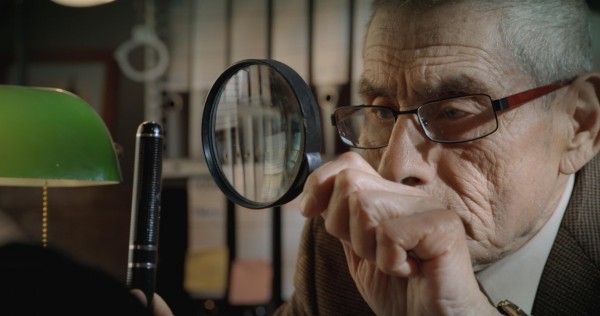
SERGIO CHAMY IN THE MOLE AGENT
An old man is set to spy on an old folks' home in this Chilean documentary hybrid
This is a clever concept that doesn't quite convince, though it does wind up providing a series of disarmingly closeup glimpses of an old people's home at the level where the old people sit around and are lonely and sometimes quite lost, even though tended to caringly by staff.
Ostensibly, Silvio is hired by a private detective, Romulo, who in turn has been hired by a lady to check and see if her mother is being properly cared for in the home.
It's initially amusing to see half a dozen men ages 80-90 being interviewed for this job and trying to convince they're capable of being undercover agents. The guy chosen, Silvio, has a precise quality, is on the ball, tidily dressed, and mannerly: good choice! He even seems to pick up on how to use a smart phone and several spy recording devices. This whole thing is a very novel idea. However, the old folk's home plainly is aware that they're being filmed. What we see is not just from a hidden camera, though as part of the film we hear Silvio's phone calls and messages to his detective boss and see his secret videos. His tour of duty is to be three months.
There is one human value to Silvio's job. He has, reportedly, lost his wife just a few months earlier. It does him good to get out of the house, away from being constantly reminded of his late spouse. In the home there are 40 women and 4 men, and Silvio's instantly the most "eligible" man and thus the object of constant admiration, attention, even love from the old ladies. He is fussed over and celebrated - exaggeratedly so. He's made, like a prom king, "king" of the home, and later given a spectacular birthday party. He is to spend three months here. How sad the ladies will be to see him go!
The "blanco," the target, turns out to be a very unfriendly old lady, who rarely speaks to anyone and spends most of her time in her room. There is little to report on, but also nothing discernible wrong in her treatment. The bulk of what will seem a pretty long and repetitious 84 minutes is devoted to Silvio's interactions with the old ladies and the cameraman's observation of them.
Early on one lady observes that she finds it sad when a man who is capable of coping on his own chooses to check into a place like this, a very telling point. Silvio seems to be a great help here providing cheer and support to the others. Obviously this fills a need for him, too. He was lonely at home. He perhaps isn't here.
The filmmakers lean toward observation of old ladies who either are quite enamored of Silvio, or are losing their marbles. Various ones believe their mothers are still alive and keep calling for them, to be taken home. One of them cannot remember if her family has visited her or not. Silvio checks, and finds no one has visited her all year. It's pathetic and sad to contemplate such loneliness and uselessness. It's sad to realize that many old lives are like this and many old people's homes are like this. The cute premise of the film goes sour after a while, despite the self possession and good cheer of the protagonist.
The Mole Agent/El agente topo 84 mins., debuted Jan. 2020 at Sundance, playing at 15 other festivals, including New Directors/New Films, as part of the delayed virtual pandemic version of which it was screened for this review, chosen as Closing Night Film for ND/NF. Metacritic: 71%. Chile's Best International Feature Oscar entry.
Last edited by Chris Knipp; 12-14-2020 at 10:08 AM.
-
GIRAFFE (Anna Sofie Hartmann 2019)
ANNA SOFIE HARTMANN: GIRAFFE (2019)
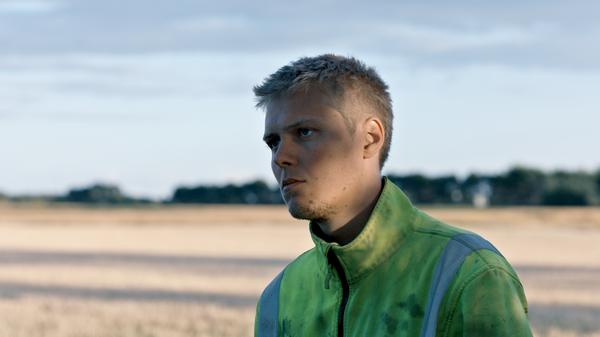
JAKUB GIERSZAL IN GIRAFFE
Meditations, speculations and lovemaking in a summer on a Danish island
Danish director Anna Sophie Hartmann in the enigmatically titledGiraffe, delivers a cool but enticing slice of beautiful color photography, meditation, and summer love. At the center is Dara (Norwegian star oLisa Loven Kongsli of Force Majeure), a 38-year-old woman somewhat at loose ends (and at the moment unattached) on the Danish island of Lolland, where a tunnel connecting Denmark to Germany is being built that will wipe out farms and houses. She is working as an ethnologist preparing a generational history of the region that's going to be demolished, ruminating over and reading diary entries from years past, in particular those of a librarian named Agnes Sørenson. Meanwhile Polish construction workers are extending big fiber cable lines, and Dara meets one of them, young Lucek (Jakub Gierszał), who has a soft, disarmingly accentless voice in English. They make love. And it goes on for a while. Kongsli and are great together.
The director blends these actors with real people, some of whom are used in staged scenes, some interviewed. The effect is to show fiction as moments of dipping into lives as the film surveys past and present. There are farmers about to give up their farms to be turned into asphalt or a tunnel, whose family has been there for three generations and were hoping to continue for four or five. Others are younger, newcomers, and not concerned. Lucek just wants to stay working there till the autumn so he can be with Dara. Dara wants to find someone who used to know Agnes Sørenson. And I just want to look at the images by dp Jenny Lou Ziegel,, which at times have some of the unexpected beauties anthologized in Sally Eauclaire's landmark 1981 New Color Photography. It's almost 40 years later, but one realizes that the color images in movies rarely have the beautiful simplicity of those still photographers who revitalized color in the late seventies. Color photography can still be fresh. The use of middle distance and classic golden rectangle aspect ratio with doors, windows, and clear summer light create one delightful effect after another. The images have an openness and limpidity that reinforces the meditative, relaxed feel of the film, making the love story and the revelations of people's lives come naturally.
There is another character, Käthe (Maren Eggert), who works on the ferry, and somewhat like Dara, but as a hobby, likes to review lives, looking at people standing on the boat and imagining what they do and who they are.
This mixture of land, history, and people seen in layers, led Peter Bradshaw, in his Guardian review, to connect this film with Sebald's The Rings of Saturn, which combines a walking tour of Suffolk with meditations prompted by places and people encountered along the way. That works. But Sebald didn't have these visuals. Or a sexy love affair.
Giraffe, mins., debuted at Locarno Aug. 2019, showing at half a dozen other international festivals including Hamburg, Vienna, Thessaloniki and the delayed virtual pandemic edition of the 2020 New Directors/New Films series, where it was screened for this review in Dec. 2020.
Last edited by Chris Knipp; 12-14-2020 at 10:16 AM.
-
THE SHEPHARDESS AND THE SEVEN SONGS (Pushpendra Singh 2020)
PUSHPENDRA SINGH: THE SHEPHERADESS AND THE SEVEN SONGS (2020)

NAVJOT RANDHAWA IN THE SHEPHERDESS AND THE SEVEN SONGS
Kashmir politics and feminism overburden this pretty but undynamic tale
This film's greatest asset is its beautiful northeastern Indian green mountainous landscape, which at the end, flows off into snow covered mountain and then pure snow, as the heroine, Laila (Navjot Randhawa), walks away wearing only a thin snakeskin she has draped over her shoulders. The basis is the Rajasthani writer Vidaydan Detha’s story of a woman discarding all identities society wants to impose on her. It may not feel like a very positive image. A trouble with the film is that the folktale base is repetitious and the tale of libidinous men and a teasing woman hasn't the wit or edge of, say, Boccaccio. Laila, the nomadic shepherdess, we're supposed to see as a feminist heroine but it's hard to see her as winning out at the end, if she walks off naked into the mountains. It's also hard to see the message of the man not her husband who is crazy for Laila (is he like Majnun Laila in Arab culture?). He doesn't seem like a bad guy or a fool. And what's happening to Laila's husband Tanvir (Sadakkit Bijran)? Why is he supposed to be a coward? There never seems to be real danger he's dodging. It's all a silly game.
Inspired, we're told, by the poetry of 14th century Kashmiri mystic Lalleshwari, also known as Lalla or Lal Ded, and set against the backdrop of the conflict in Kashmir, this is a film that carries a considerable weight. There is a moment of contemporary politics when the locals are told they can no longer travel with their sheep from terrain to terrain freely but must have individual ID cards. "We're poor, we can't do that," they say, and the cop answers, "Get real, everybody has to."
Singh, the director, has assembled an impressive bare bones folk production that maximizes the beauty of the people, their simple sheepherding lifestyle, their graceful costumes, and the landscape, which is always photographed to good advantage. It is when Laila's questioning voiceovers come, with the occasional striking musical interlude, that the film shines and begins to take on significance.
The seven songs, however, are a few too many, and one loses track of them after a while. Nor is the wrangling of groups a success, as we see early on in the interlude where Tanvir passes the groom test of lifting the heavy rock. The crowd of men is chaotic and ineffective. So we have to conclude that this is strictly festival stuff - though, sadly, probably not included in as many festivals as it deserved to do, due to the pandemic.
The Shepherdess and the Seven Songs (Laila aur satt geet), 96 mins., debuted at the Berlinale in Feb. 2020; listed in seven other festivals on IMDb, including Hong Kong, Singapore and New Directors/New Films; it was in the delayed Dec. 2020 pandemic virtual form of the latter that it was screened for this review.
Last edited by Chris Knipp; 12-19-2020 at 01:41 AM.
-
THE CLOUD IN HER ROOM 她房间里的云 (Zheng Lu Zinyuan 2020)
ZHENG LU XINYUAN: THE CLOUD IN HER ROOM 她房间里的云 (2020)
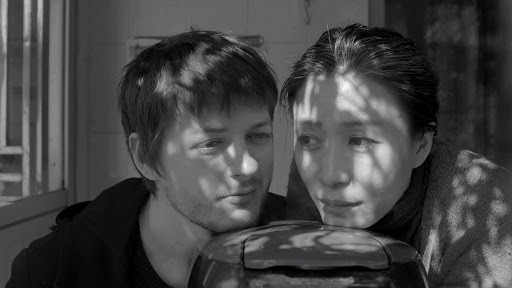
MATTIAS DELVAUX, LIU DAN IN THE CLOUD IN HER ROOM
Young Chinese woman director enters her own personal Nouvelle Vague
Zheng Lu Zinyuan, who studied film at USC, has done something a bit different for her feature debut. She has not made a bildingsroman, nor a portrait of a Chinese generation in transition like the early films of Jia Zhang-ke. This is a cinematic study in hanging out. It's vaguely autobiographical - the main character, Muzi (Jin Jing), is of the director's sex, age and generation. But if you focus too much on what's happening in the picture, you're missing the point. The delight of this loosely-slung-together piece of casually experimental filmmaking- and it does have such delight to offer if you don't push it too hard - is in its casualness, a diaristic flavor so loose even the specificity of a diary entry is asking a bit much. It's just the celebration of being there, letting the camera follow things around.
Ture, this is in its meandering way a vaguely autobiographical portrait of Muzi as she returns to her waterway-rich, typically torn-apart 9-million population mainland Chinese hometown of Hangzhou (also Zheng's city of origin). She is ostensibly on hand there for New Year's celebrations, personal reunions with family members, and her twenty-second birthday. But mainly she's hanging out. She has two possible boyfriends. There's the young laidback painter and photographer about her age, Yu Fei (Chen Zhou), and the older new guy she meets, , Dong Kang-ming, a drummer who runs a bar. Dong may be more interesting to the young Muzi. But is he more interested? But how interested is Yu Fei? These are questions casually explored off and on in the film.
There's also an old apartment her parents used to occupy that's vacant now, still rented by her father. She goes there with Yu Fei, who has come to Hangzhou by surprise to see Muzi and, in a bedroom, they have sex. At that point, they're clearly both interested.
But what's "happening" is beside the point. This is more the opportunity to meander around the town, try to find something familiar, to cast an eye around. For us and for Zheng Lu Zinyuan, it's also an opportunity to admire the soft black and white of her talented young Belgian cinematographer, Matthias Delvaux (a China resident and dp of Zhou Ziyang's Old Beast, who also briefly plays the new boyfriend of Min (Liu Dan), Muzi's mother. Delvaux lightens everything a bit, and, more radically, a couple of times gives us the negative so everything goes exotic and dark. Mostly Delvaux here makes things look like seventies fashion photography, mitigating the harshness of modern China and further encapsulate Muzi in her own personal world - except for one thing: even during an intense sex scene, we hear the clangor of the city outside.
Muzi says every time she comes back to Hangzhou it seems stranger to her, and her personal world is fragmented. Her musician father, Feng (Ye Hongming) has remarried and is the father of a young daughter, and her mother seems to get drunk a lot and have various boyfriends. All are big smokers. Smoking and drinking have always been screen staples; this is a reminder of that. And of how much this feels, at moments, like a French film. Sadly, without Paris. But there's something new here.
And yet the chief appeal of Zheng Lu Zinyuan's filmmaking may be its unformed quality, or its ability to capture that quality in its protagonist - the sense that while Muzi is moving around the fragments of her family and the great, transforming city independently, she is yet uncertain, a quality suggested by her clunky shoes. Clearly the director has some clunky shoes too, but not as clunky; and her boldness and freedom bode well.
TRAILER
The Cloud in Her Room 她房间里的云 (Ta fang jian li de yun), 101 mins., debuted at Rotterdam, where it won the top prize, the Tiger Award. It is included in 6-10 other international festivals with other nomnations and awards, including Taipei, Hamburg, Hong Kong, Singapore, and Dec. 13, 2020 in the postponed Dec. virtual pandemic edition New Directors/New Films series, as part of which it was screened for this review.
Last edited by Chris Knipp; 12-17-2020 at 04:06 PM.
 Posting Permissions
Posting Permissions
- You may not post new threads
- You may not post replies
- You may not post attachments
- You may not edit your posts
-
Forum Rules





 Reply With Quote
Reply With Quote






Bookmarks